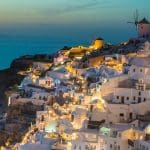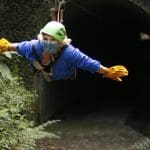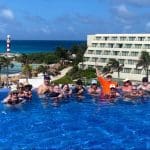COVER STORY
Dawn Bazely wants those considering High Arctic vacations to bear in mind that mighty bruins often seen as iconic of the region are far from being the only attraction there for nature enthusiasts.
In fact, much of Mother Nature’s summertime handiwork is on the itty-bitty side, she notes.
Bazely, who divides her time between teaching botany at York University and guiding and lecturing on Adventure Canada sailings, realizes such imposing creatures as polar bears, musk-ox and walruses often come quickly to mind when people think of the High Arctic but says summertime plant life – including flowers – often seen can be intriguing as well.
“I’m delighted when guests get amazing photos of the flowers – it’s a lot like the excitement I see on the faces of undergrad students in biology labs,” says Bazely, who has worked in different Arctic regions.

Archeologist Chris Wolff, a lecturer on Adventure Canada’s High Arctic Explorer cruise, stands by the graves of members of the 1845 Franklin Expedition.
“Actually, the Arctic is a great place to learn flower identification, because there aren’t too many species and someone interested in plant ID can easily master these few species and build their base from which to branch out to learning to sport and identify plants in habitats with greater biodiversity. In southern Ontario, for example, there are estimated to be around 2,200 plant species while there are only 500 in Greenland.”
Adventure Canada, in operation for decades, is likely best known for its Arctic and High Arctic tours, among them High Arctic Explorer, which begins in the remote Nunavut community of Resolute Bay and ends on the west coast of Greenland. This year’s sailing ran Aug. 6-17.
The company says the August tour that uses the 198-guest Ocean Endeavour enables guests to see the area’s natural side, at one point working its way through Lancaster Sound, which guide Jim Narraway labels “the Serengeti of the Arctic” because of diverse marine life that includes bowhead whales, narwhals and polar bears.
Expedition leader Jason Edmunds says Adventure Canada first sends staff ashore before passengers make landings to ensure that any spottings of the North’s mightiest predators will be from a safe distance.
“This is not our home,” he says of polar bears. “It’s theirs.”
Muskox, whales and narwhals may also be spotted, with Edmunds noting that many southerners “don’t think narwhals exist,” and are simply mythical creatures.
But Edmunds adds that the cruise – one of several Adventure Canada offers in the Arctic – doesn’t focus on wildlife alone, adding participants will gain insights into the region’s landscapes, culture and history.
They’ll also learn of the impact global warming is having on the region.
Indeed, Adventure Canada has Inuit staff on its High North sailings and the High Arctic sailings call at the predominantly Inuit northern Baffin community of Pond Inlet and at points on the western coast of Greenland that are again mostly Inuit.
The sailing also visits Beechey Island, burial site of three members of the 1845 Franklin Expedition, which set off from Britain with two ships and over 129 men in search of the Northwest Passage. The expedition was last seen by whalers in the Arctic before disappearing, with none of its members seen alive again. Subsequent searches in led to the findings of graves on Beechey of three expedition members and a fourth headstone marks the final resting place of a sailor who died on a search party that set out in 1854 in search of the expedition. The finding of their two sunken vessels in recent years generated international attention and the Beechey Island graves are now a historic site.
Another trip highlight is visiting the western Greenland community of Ilulissat, with the area known for spawning a huge number of icebergs. Adventure Canada provides Zodiac excursions among the icebergs.
“If you think of the traffic in Toronto on a Friday evening – this is the equivalent for icebergs,” Bazely says.
Ocean Endavour crew member Armando Borjas Gutierrez adds those whose dream vacation is in a part of the world where there are few people and little human activity will be in their element on the High Arctic sailing.
“It’s a very quiet place, a place where you can be in contact with nature,” he states of the region.
This year’s High Arctic Explorer rates ranged from US$6,995 to US$18,695 and included air transportation from Ottawa to Resolute and Greenland to Toronto, the cruise, all meals, Zodiac and land excursions, an Adventure Canada windbreaker, and an overnight in Ottawa.
The Ocean Endeavour has a 1B ice class, enabling it to explore throughout the Arctic summer. Ship features include a spa, library, lounges, restaurant,sauna, pool, Zodiacs and hot tub.
Cabins have bathrooms, flat-screen TVs and phones.
Nunavut site was home to isolated RCMP post
By IAN STALKER
Was a remote and now abandoned RCMP post on the High Arctic’s Devon Island the scene of a great divide?
The isolated Nunavut site was home to an RCMP post in the early 20th century, part of a plan by Ottawa to boost Canada’s presence in the Arctic.
The Mounties stationed there would go long periods without seeing other people, relying on each other for company.

The graves of two RCMP officers can be found on a remote site on Devon Island.
But one story has it that two officers who had to share a smallish dwelling grew to hate each other and so drew a line down the centre of the structure, with each Mountie agreeing to stay on his own side of the line.
Adventure Canada visits the site on its High Arctic Explorer cruise, with visitors able to see a cluster of now-abandoned wooden structures.
Adventure Canada guide John Houston says some Mounties sent there were in danger of being dismissed from the force because of sub-par performances and agreeing to the posting was seen as giving them a final chance to redeem themselves in the eyes of their superiors.
A poignant side to the site is a small graveyard home to the final resting place of two Mounties who died there, with Houston suggesting it was unlikely their families were ever able to visit the gravesites because of their inaccessibilty.
One Mountie’s death was said by the RCMP to have resulted from an accidental firearms discharge, although some suggest he deliberately killed himself because of the strain of living in such a far-off spot and the RCMP told his family his death was an accident to soften the blow.
BARTENDER WAS THE BEAR-ER OF bailey’s
By IAN STALKER
Emilly Castro is a very mobile b(e)artender.
Castro, who serves drinks on the Ocean Endeavour, used by Adventure Canada on its High Arctic program, may surprise Adventure Canada clients on one of their Zodiac excursions as well.

Dressed for the High Arctic occasion is Emilly Castro.
A recent Nunavut-Greenland sailing saw Castro and other crew members unexpectedly arrive in a Zodiac alongside Zodiacs carrying passengers viewing ice formations, with Castro sporting a polar bear outfit with an agape mouth and offering Adventure Canada clients hot chocolate laced with Bailey’s.
“Do you realize there’s a polar bear in your boat?” one Adventure Canada customer asked the operator of Castro’s Zodiac when the waterborne welcome wagon arrived.
Adventure Canada is careful that customers who visit the Arctic don’t get dangerously close to polar bears but Brian Faber, the director of client services for the company says Castro’s sudden appearance didn’t amount to a security lapse.
“There was no threat to passengers,” he reassures.

















